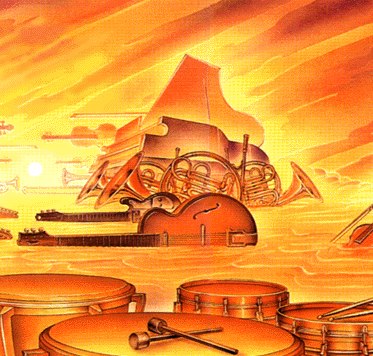Remembering Alan: ‘Campus literally stopped’ when art prof died
April 29th, 2013 Posted in Arts and LifeBy Katie Swain
LOGAN—Spontaneous. Quirky. Blunt. Creative. Honest. Persistent. Maverick. Mentor. Innovator. Devoted. Rebellious. Whirling dervish. Hurricane. A tornado of ideas.
That was Alan Hashimoto, the Utah State University graphic design professor who died in February at age 58 in his office. The response from the students and faculty has been intense and emotional.
“He affected so many people,” said Meagan Roach, one of Hashimoto’s students. “Campus literally stopped because of his passing in a moment of silence.”
As students, colleagues, friends and family—he left a wife and two young children—began processing Hashimoto’s death, it became clear how devoted students were to him on a level most professors and people in general never reach.
Almost immediately after his death, students began organizing events to meet and grieve together. The Facebook page “In Memory of Alan Hashimoto” was created for friends, students, colleagues and everyone affected by Hashimoto’s life, to share thoughts and memories.
“Alan had such devoted students because he was so devoted to them,” said Kate Auman, one of his video students. “He bent over backwards for us to offer things out of regular curriculum. He filled in the gaps to meet the passions and interests the students had.”
Once you connected with Hashimoto, said graphic design major Jesse Budd, it felt like you were part of the “Alan Club.”
“I think students reacted the way they did because Alan really opened up his whole life to his students,” said Jeremy Jensen, a graphic design graduate student who worked closely with Hashimoto. “He treated you as a student, but at the same time he was your friend. He was a guy you could sit down with and chat for hours. He put everyone on the same level. He didn’t talk to you different because you were a student.”
Hashimoto’s intensities and passions made him a complex man, however. His bursting energy and sometimes scattered thoughts could make him difficult to work with.
“Alan only had one speed, and that’s fast-forward,” USU President Stan Albrecht said at a memorial gathering in March.
Jensen said Hashimoto appeared scattered because he was involved with so much and was constantly “juggling so many things in his mind.”
“The guy had a billion ideas,” Jensen said. “His brain was just incredibly creative. He could throw a hundred ideas at you in the time you’d thought about one. His mind was just moving ’way faster than your average human. He came across as ADD or scattered, but really I think he was just brilliant.”
Hashimoto was also known for his unique teaching style and honesty.
“Unlike most professors or teachers I’ve had, Alan was actually honest with me and my work,” Auman said. “He didn’t tell me I was good when I sucked. This might seem like something that most people wouldn’t like, but it made my work stronger. His blunt criticism helped me see my potential and didn’t allow me to skim by. He made me work my hardest even if it meant ripping up a video I had been working on for hours to start over again.”
Jensen agreed. “Alan wouldn’t even let you start on a bad idea,” he said. “If your idea sucked, he’d tell you.”
From Hashimoto’s daily all-black attire, to his trademark jokes about running his classes like church meetings, Hashimoto’s quirks were well known.
“How wasn’t Alan quirky?” Auman said. “At his memorial, upon his request, he had Way Way East Bay (a USU faculty musical group) jam out. And I think that shows you a lot. He was a celebrator and a really really funny dude.”
It was fitting, friends say, that the AC/DC song “Highway to Hell” played at his memorial celebration.
“Alan got stuff done by constantly talking about it,” said Budd, Hashimoto’s graphic design student. “He had certain parts of his mind that he would store information in that were triggered by seeing you. It’s like your face was a Post-it note on a fridge.”
Art professor Bob Winward, Hashimoto’s graphic design colleague at USU, said Hashimoto’s inherent resistance to “The Man” was a lot of what defined him and pushed his work.
“His biggest quirk was that rebellion was the most powerful gene in all his DNA,” Winward said. “It’s what made him so creative—and many times so frustrating—to those around him. In fact, rebellion was such a huge part of his makeup that he often times rebelled against his own ideas.”
Among other subjects, Hashimoto taught typography, interactive media and design courses, and led an art study abroad program in Austria. His research with colleagues created online, interactive games, and he was an art director and consultant in digital applications for assortment of outlets. Hashimoto was also a big part of the development of Poptropica, an interactive online environment for kids developed by Family Education Network that has more than 20 million Internet users.
“He wanted to organize a setting that would cause creativity to naturally flow from the people involved,” Budd said. “He once told me that he knew all the theories and ‘rules,’ but he didn’t like teaching them.”
Winward says that was part of Hashimoto’s rebellious streak.
“He didn’t have patience with bureaucratic systems and, like an all-powerful force of nature, barreled his way through, over and under red tape to make things happen,” Winward said.
Hashimoto earned a bachelor’s degree from USU and a master’s from University of Oregon. He then spent a number of years working as a commercial artist in Los Angeles and New York before returning to USU, where he taught for 25 years.
Art and Design Department head Laura Gelfand remembered Hashimoto as “a force of nature.”
 “His energy was boundless as was his creativity,” she said. “He touched so many lives in such positive ways, he will be terribly missed by everyone who was lucky enough to know him.”
“His energy was boundless as was his creativity,” she said. “He touched so many lives in such positive ways, he will be terribly missed by everyone who was lucky enough to know him.”
That energy endured over decades for one USU undergraduate classmate.
“I’ll miss Al’s energy,” said Patrick Cone, a Park City photographer and college friend who lived with Hashimoto in L.A. “We always had great, intense conversations about life and teaching.
“I’m glad he went into teaching; it probably saved his life, as city life was tearing him apart,” Cone said. “Plus he always said, ‘If you can’t teach, do.’ Well Al, it turned out, could do both.”
Hashimoto was also a family man. He was deeply devoted to his wife Amy, and their sons, Oliver and Simon. They often accompanied Hashimoto to campus, and went on the study abroad trip he led to Europe.
“The day of his passing, he’d taken the boys to school early, so he could stop by Einstein’s for a special breakfast before school,” Winward said. “That will be a great memory for his boys.”
Alan Hashimoto will not be an easy man to forget.
“I didn’t know him that long, but I feel like I knew him forever,” said student Austin Allen. “I’ve always wanted to have a sort of video mentor in my life—a trainer, if you will. That was Alan. Like I was the Karate Kid and he was my trainer. And I actually mentioned that to him and he was like, ‘Oh I worked on Karate Kid.’
“He did everything.”
TP
Tags: Alan Hashimoto, graphic design, Patrick Cone




Sorry, comments for this entry are closed at this time.